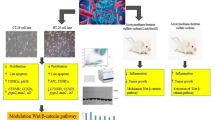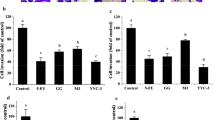Abstract
Microbiota of lower female reproductive tract is special in its microorganism composition with Lactobacillus as the predominant bacteria. A few of Lactobacillus species have been identified to benefit the inhibition of inflammatory and malignant diseases. Lacticaseibacillus casei LH23 is a strain isolated from traditional fermented food and had been demonstrate to ameliorate DSS-induced colitis in mice. In the present study, effects of Lacticaseibacillus casei LH23 on cervical cancer cells were investigated. Supernatants of lysates and heat-inactivated Lacticaseibacillus casei LH23 were found to inhibit the expression of human papillomavirus genes E6/E7 which is the main causative factor of cervical cancer. With MTT, EdU staining, and TUNEL staining assays, Lacticaseibacillus casei LH23 was shown to suppress the proliferation and induced the apoptosis of cervical cancer cells. Additionally, with wound-healing and Western-blot assays, Lacticaseibacillus casei LH23 was shown to slowdown the migration of cervical cancer cells and altered the expression of metastasis-related genes. These results demonstrated the anti-cervical cancer potential of Lacticaseibacillus casei LH23.




Similar content being viewed by others
Availability of Data and Material
All data generated during this study are included in this published article. Materials are available upon reasonable request.
Abbreviations
- HPV:
-
Human papillomavirus
- LAB :
-
Lactic acid bacteria
- EMT:
-
Epithelial to mesenchymal transition
References
Crosbie EJ, Einstein MH, Franceschi S, Kitchener HC (2013) Human papillomavirus and cervical cancer. Lancet 382(9895):889–899. https://doi.org/10.1016/S0140-6736(13)60022-7
Hoppe-Seyler K, Bossler F, Braun JA, Herrmann AL, Hoppe-Seyler F (2018) The HPV E6/E7 oncogenes: key factors for viral carcinogenesis and therapeutic targets. Trends Microbiol 26(2):158–168. https://doi.org/10.1016/j.tim.2017.07.007
Wise-Draper TM, Wells SI (2008) Papillomavirus E6 and E7 proteins and their cellular targets. Front Biosci 13:1003–1017. https://doi.org/10.2741/2739
He H, Lai Y, Hao Y et al (2017) Selective p300 inhibitor C646 inhibited HPV E6–E7 genes, altered glucose metabolism and induced apoptosis in cervical cancer cells. Eur J Pharmacol 812:206–215. https://doi.org/10.1016/j.ejphar.2017.06.005
Gao X, Jin Z, Tan X et al (2020) Hyperbranched poly(beta-amino ester) based polyplex nanopaticles for delivery of CRISPR/Cas9 system and treatment of HPV infection associated cervical cancer. J Control Release 321:654–668. https://doi.org/10.1016/j.jconrel.2020.02.045
Zhen S, Lu J, Liu YH, Chen W, Li X (2020) Synergistic antitumor effect on cervical cancer by rational combination of PD1 blockade and CRISPR-Cas9-mediated HPV knockout. Cancer Gene Ther 27(3–4):168–178. https://doi.org/10.1038/s41417-019-0131-9
Norenhag J, Du J, Olovsson M, Verstraelen H, Engstrand L, Brusselaers N (2020) The vaginal microbiota, human papillomavirus and cervical dysplasia: a systematic review and network meta-analysis. BJOG 127(2):171–180. https://doi.org/10.1111/1471-0528.15854
Mitra A, MacIntyre DA, Marchesi JR, Lee YS, Bennett PR, Kyrgiou M (2016) The vaginal microbiota, human papillomavirus infection and cervical intraepithelial neoplasia: what do we know and where are we going next? Microbiome 4(1):58. https://doi.org/10.1186/s40168-016-0203-0
Petrova MI, Lievens E, Malik S, Imholz N, Lebeer S (2015) Lactobacillus species as biomarkers and agents that can promote various aspects of vaginal health. Front Physiol 6:81. https://doi.org/10.3389/fphys.2015.00081
Usyk M, Zolnik CP, Castle PE et al (2020) Cervicovaginal microbiome and natural history of HPV in a longitudinal study. PLoS Pathog 16(3):e1008376. https://doi.org/10.1371/journal.ppat.1008376
Chen Y, Qiu X, Wang W et al (2020) Human papillomavirus infection and cervical intraepithelial neoplasia progression are associated with increased vaginal microbiome diversity in a Chinese cohort. BMC Infect Dis 20(1):629. https://doi.org/10.1186/s12879-020-05324-9
Mitra A, MacIntyre DA, Lee YS et al (2015) Cervical intraepithelial neoplasia disease progression is associated with increased vaginal microbiome diversity. Sci Rep 5:16865. https://doi.org/10.1038/srep16865
Mitra A, MacIntyre DA, Ntritsos G et al (2020) The vaginal microbiota associates with the regression of untreated cervical intraepithelial neoplasia 2 lesions. Nat Commun 11(1):1999. https://doi.org/10.1038/s41467-020-15856-y
Wang KD, Xu DJ, Wang BY, Yan DH, Lv Z, Su JR (2018) Inhibitory effect of vaginal lactobacillus supernatants on cervical cancer cells. Probiotics Antimicrob Proteins 10(2):236–242. https://doi.org/10.1007/s12602-017-9339-x
Riaz Rajoka MS, Zhao H, Lu Y et al (2018) Anticancer potential against cervix cancer (HeLa) cell line of probiotic Lactobacillus casei and Lactobacillus paracasei strains isolated from human breast milk. Food Funct 9(5):2705–2715. https://doi.org/10.1039/c8fo00547h
Łaniewski P, Ilhan ZE, Herbst-Kralovetz MM (2020) The microbiome and gynaecological cancer development, prevention and therapy. Nat Rev Urol 17(4):232–250. https://doi.org/10.1038/s41585-020-0286-z
Koirala R, Gargari G, Arioli S et al (2020) Effect of oral consumption of capsules containing Lactobacillus paracasei LPC-S01 on the vaginal microbiota of healthy adult women: a randomized, placebo-controlled, double-blind crossover study. FEMS Microbiol Ecol 96(6):fiaa084. https://doi.org/10.1093/femsec/fiaa084
Laue C, Papazova E, Liesegang A et al (2018) Effect of a yoghurt drink containing Lactobacillus strains on bacterial vaginosis in women — a double-blind, randomised, controlled clinical pilot trial. Benef Microbes 9(1):35–50. https://doi.org/10.3920/BM2017.0018
Liu M, Ding J, Zhang H et al (2020) Lactobacillus casei LH23 modulates the immune response and ameliorates DSS-induced colitis via suppressing JNK/p-38 signal pathways and enhancing histone H3K9 acetylation. Food Funct 11(6):5473–5485. https://doi.org/10.1039/d0fo00546k
Lai Y, He Z, Zhang A et al (2020) Tip60 and p300 function antagonistically in the epigenetic regulation of HPV18 E6/E7 genes in cervical cancer HeLa cells. Genes Genomics 42(6):691–698. https://doi.org/10.1007/s13258-020-00938-4
Nami Y, Abdullah N, Haghshenas B, Radiah D, Rosli R, Khosroushahi AY (2014) Assessment of probiotic potential and anticancer activity of newly isolated vaginal bacterium Lactobacillus plantarum 5BL. Microbiol Immunol 58(9):492–502. https://doi.org/10.1111/1348-0421.12175
Górska A, Przystupski D, Niemczura MJ, Kulbacka J (2019) Probiotic bacteria: a promising tool in cancer prevention and therapy. Curr Microbiol 76(8):939–949. https://doi.org/10.1007/s00284-019-01679-8
Jahanshahi M, Maleki Dana P, Badehnoosh B et al (2020) Anti-tumor activities of probiotics in cervical cancer. J Ovarian Res 13(1):68. https://doi.org/10.1186/s13048-020-00668-x
Sungur T, Aslim B, Karaaslan C, Aktas B (2017) Impact of exopolysaccharides (EPSs) of Lactobacillus gasseri strains isolated from human vagina on cervical tumor cells (HeLa). Anaerobe 47:137–144. https://doi.org/10.1016/j.anaerobe.2017.05.013
Wang H, Cheng X, Zhang L, Xu S, Zhang Q, Lu RA (2019) A surface-layer protein from Lactobacillus acidophilus NCFM induces autophagic death in HCT116 cells requiring ROS-mediated modulation of mTOR and JNK signaling pathways. Food Funct 10(7):4102–4112. https://doi.org/10.1039/c9fo00109c
Funding
This work was supported by the National Key R & D Program of China (2017YFD0400304) and the Natural Science Foundation of Tianjin (18JCYBJC91500).
Author information
Authors and Affiliations
Corresponding author
Ethics declarations
Conflict of Interest
The authors declare no competing interests.
Additional information
Publisher's Note
Springer Nature remains neutral with regard to jurisdictional claims in published maps and institutional affiliations.
Rights and permissions
About this article
Cite this article
Hu, S., Hao, Y., Zhang, X. et al. Lacticaseibacillus casei LH23 Suppressed HPV Gene Expression and Inhibited Cervical Cancer Cells. Probiotics & Antimicro. Prot. 15, 443–450 (2023). https://doi.org/10.1007/s12602-021-09848-7
Accepted:
Published:
Issue Date:
DOI: https://doi.org/10.1007/s12602-021-09848-7




